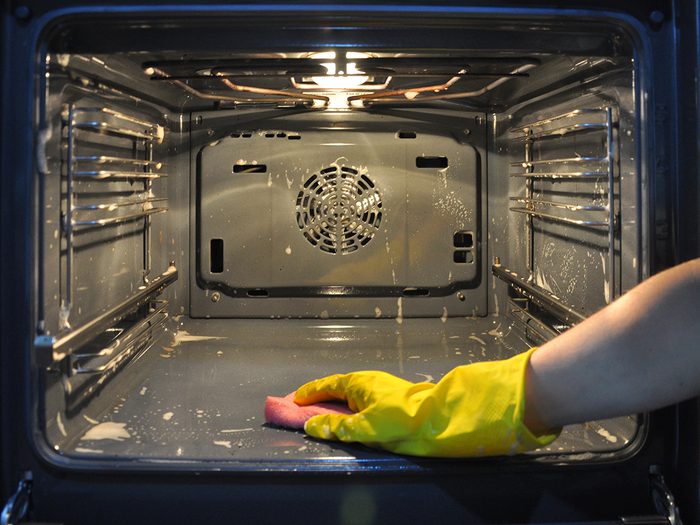
Use ammonia to clean your electric oven
Here’s a practically effortless way to clean an electric oven: First, turn the oven on, let it warm to 150° F (65°C), and then turn it off. Place a small oven-safe bowl containing ½-cup ammonia on the top shelf and a large pan of boiling water on the bottom shelf. Close the oven door, and let it sit overnight. The next morning, remove the dish and pan, and let the oven air out a while. Then, wipe it clean using the ammonia and a few drops of dishwashing liquid diluted in a quart of warm water. Even old baked-on grease should wipe right off!
WARNING: Do not use this cleaning method with a gas oven unless the pilot lights are out and the main gas lines are shut off.
Always take caution when using ammonia!
Never mix ammonia with bleach or any product containing chlorine. The combination produces toxic fumes that can be deadly. Work in a well-ventilated space and avoid inhailing the vapours. Wear rubber gloves and avoid getting ammonia on your skin or in your eyes. Always store ammonia out of the reach of children.
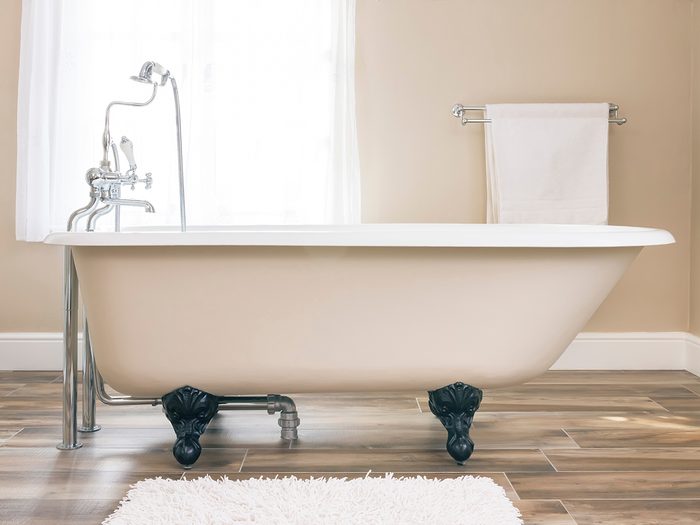
Use ammonia to remove soap and grease scum
To get rid of those unsightly soap soap and grease scum buildups in your porcelain enamel tub and sink, scrub them with a solution of one tablespoon ammonia in one gallon (3.7 litres) hot water. Rinse thoroughly when done.
Find out how to clean your bathroom in a flash.
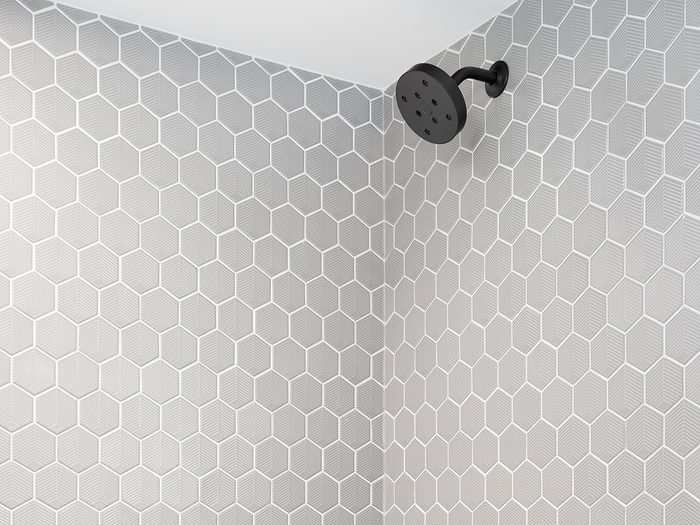
Use ammonia to clean bathroom tiles
Make bathroom tiles sparkle again—and kill mildew while you’re at it—by sponging tiled floors, backsplashes and shower enclosures with ¼-cup ammonia in 1 gallon (3.7 litres) water.
Don’t miss these green cleaning tips for your bathroom
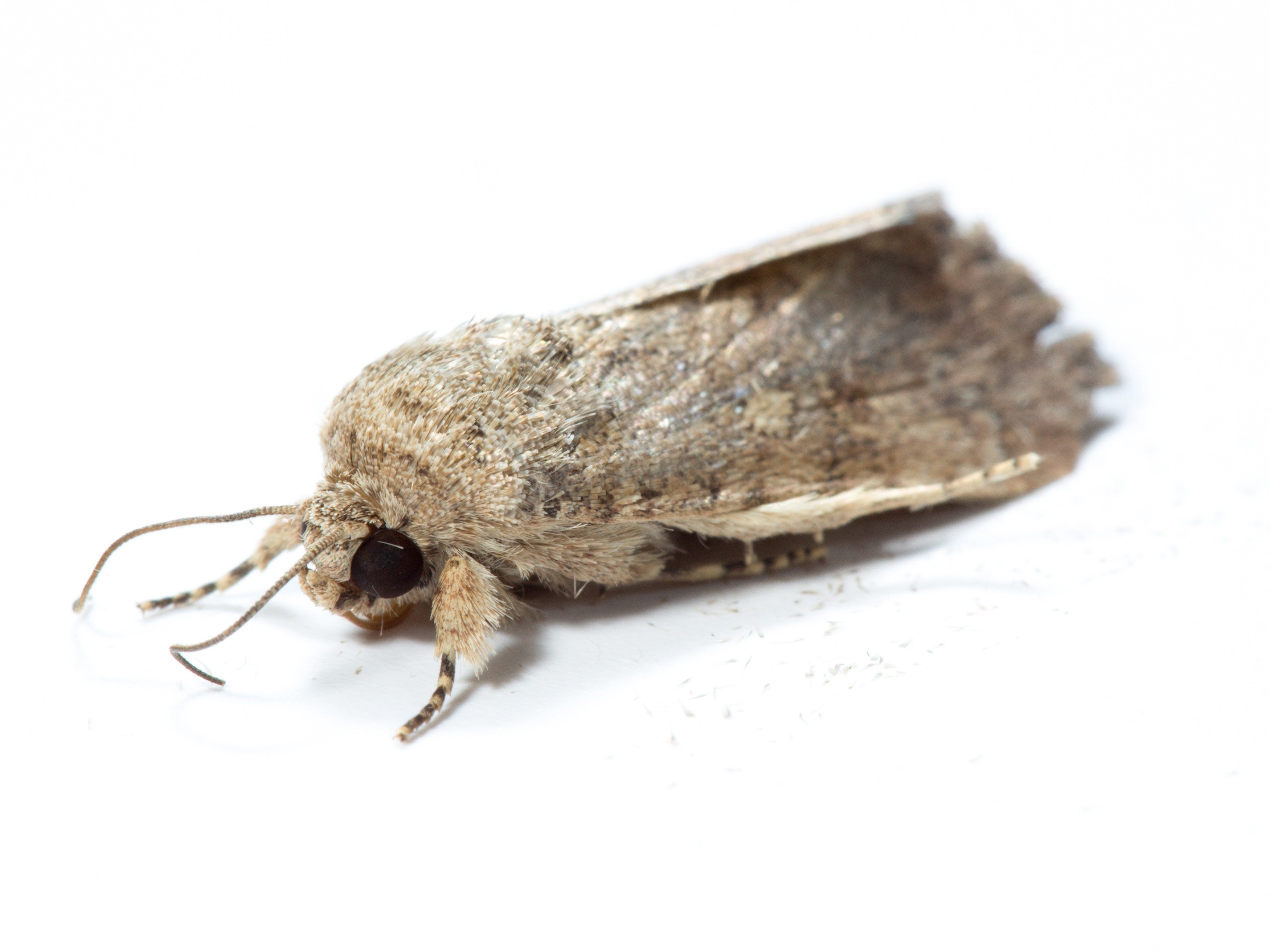
Use ammonia to repel moths
Pesky kitchen moths seem to come out of nowhere! Send them back to wherever they came from by washing your cupboards, drawers, and pantry shelves with ½-cup ammonia diluted in 1 quart (1 litre) water. Leave drawers and cabinet doors open to thoroughly air-dry.
Here are 10 more disgusting house bugs—and how to get rid of them.
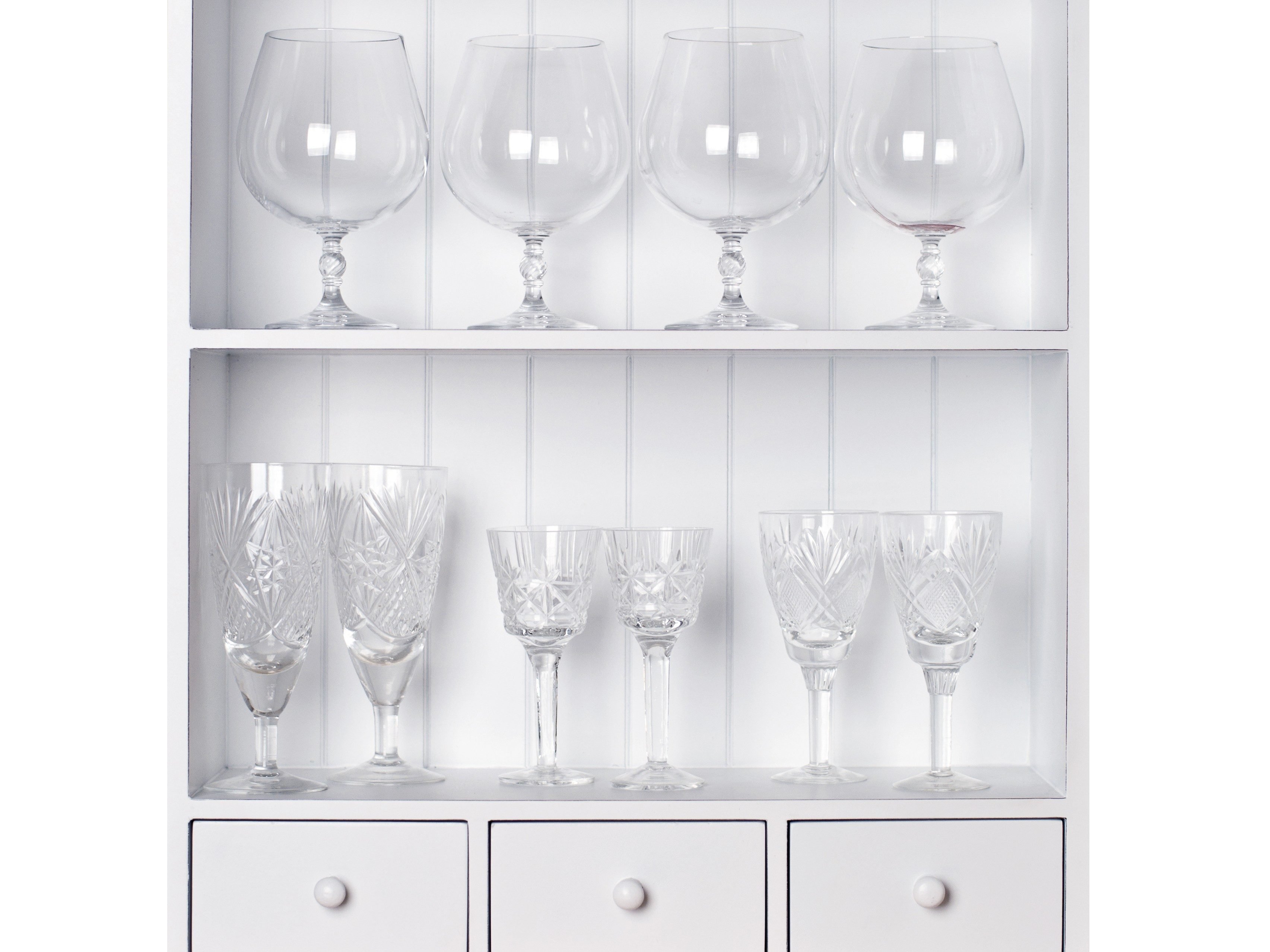
Use ammonia to make crystal sparkle
Has the sparkle gone out of your good crystal? Bring back its lost lustre by mixing several drops of ammonia in 2 cups of water and applying with a soft cloth or brush. Rinse it off with clean water, then dry with a soft, dry cloth.
Here are 30 nearly-forgotten cleaning tips from the past that have never been bettered.
Fascinating facts about ammonia
Ammonia is a colourless, pungent gas. It is easily soluble in water, however, and the liquid ammonia products sold today contain the gas dissolved in water. Ammonia is one of the oldest cleaning compounds currently in use. It actually dates back to ancient Egypt. In fact, the word ammonia is derived from the Egyptian deity Ammon, whose temple in what is now Libya is credited with producing the earliest form of ammonia, sal ammoniac, by burning camel dung!
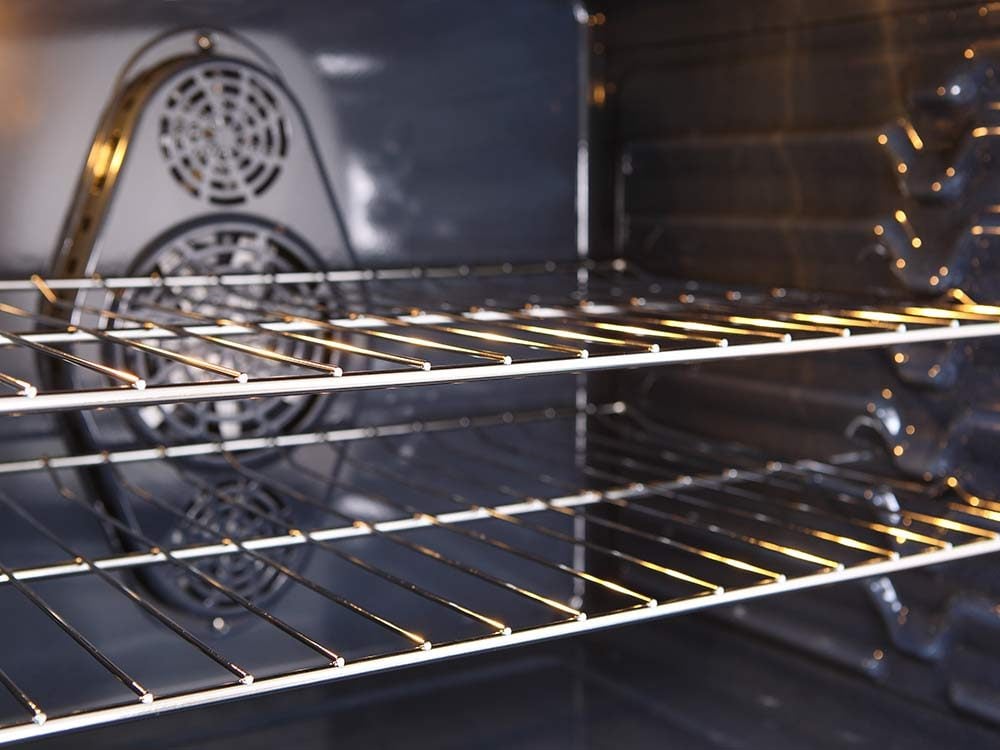
Use ammonia to clean oven racks
Get the cooked-on grime off your oven racks by laying them out on an old towel in a large washtub. You can also use your bathtub, though you might need to clean it afterward. Fill the tub with warm water and add ½-cup ammonia. Let the racks soak for at least 15 minutes, then remove, rinse off, and wipe clean.
You’ve probably never cleaned this part of your oven—and it’s filthy!
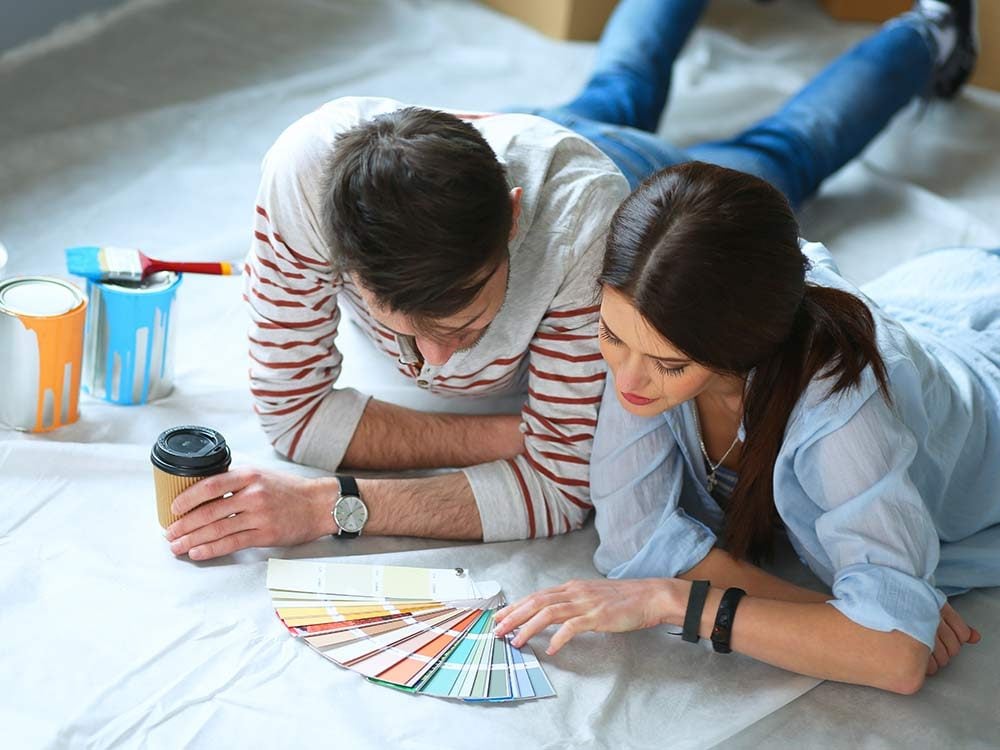
Use ammonia to eliminate paint odours
Your freshly painted home interior sure looks great, but that paint smell is driving you up the wall! There’s no need to prolong your suffering, though. Absorb the odour by placing small dishes of ammonia in each room that’s been painted. If the smell persists after several days, replenish the dishes. Vinegar or onion slices will also work.
Find out more clever hacks to get rid of household odours.
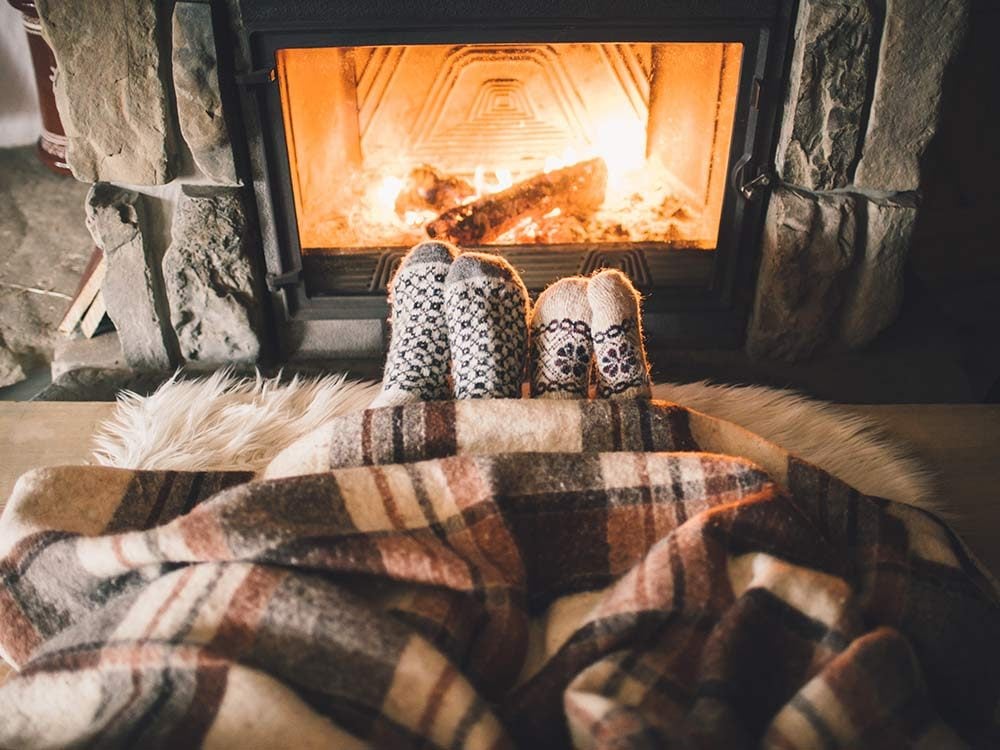
Clean fireplace doors
Think you’ll need a blowtorch to remove that blackened-on soot from your glass fireplace doors? Before you get out the goggles, try mixing 1 tablespoon ammonia, 2 tablespoons vinegar, and 1 quart (1 litre) warm water in a spray bottle. Spray on some of the solution; let it sit for several seconds, then wipe off with an absorbent cloth. Repeat if necessary—it’s worth the extra effort.
Here are more cleaning tricks for hard-to-remove stuff.
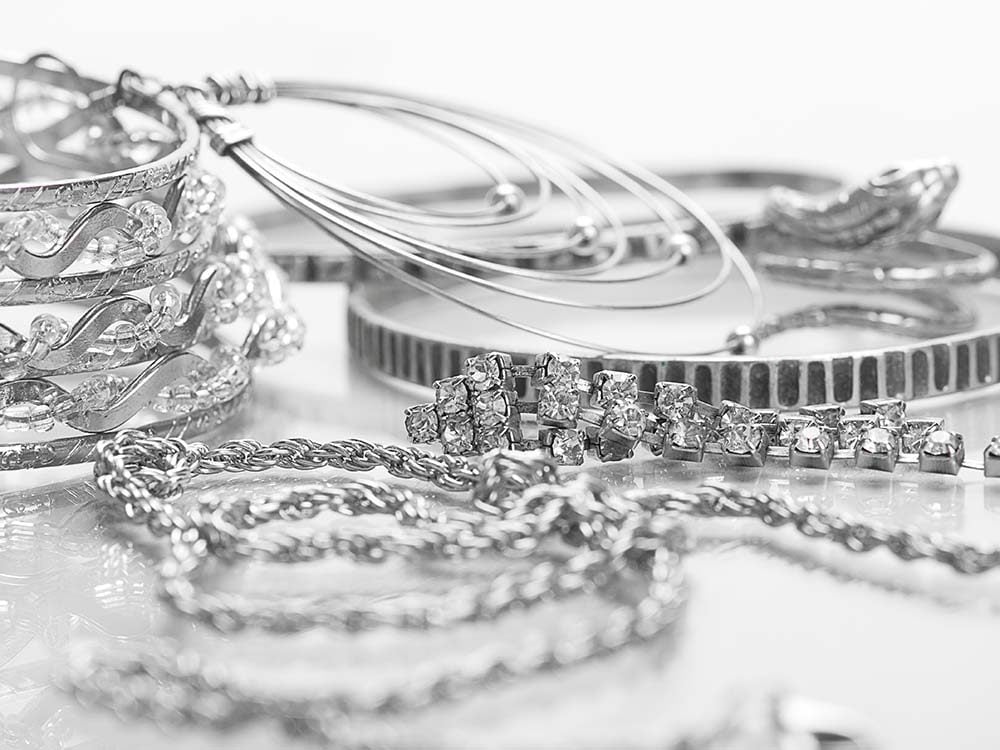
Cleaning jewelry with ammonia? Read this first!
Brighten up your gold and silver trinkets by soaking them for 10 minutes in a solution of ½-cup clear ammonia mixed in 1 cup warm water. Gently wipe clean with a soft cloth and let dry. Do not attempt this with jewelry containing pearls, because it could dull or damage their delicate surface!
Here are more silver cleaning tricks that actually work.
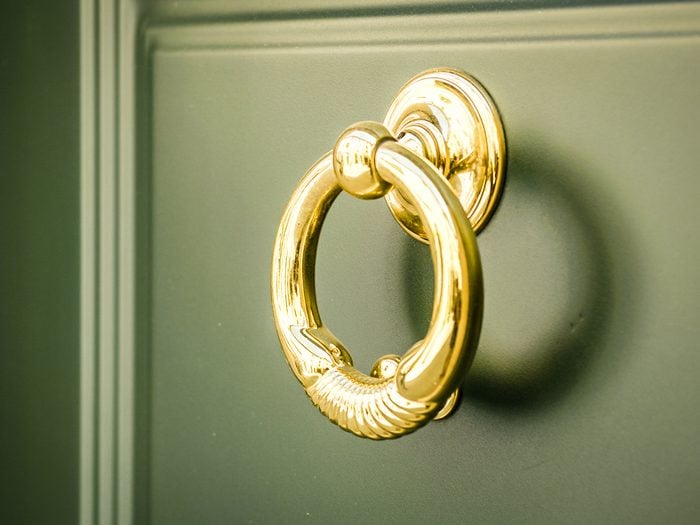
Remove tarnish from brass or silver
How can you put that sunny shine back in your varnished silver or lacquered brass? Gently scrub it with a soft brush dipped in a bit of ammonia. Wipe off any remaining liquid with a soft cloth—or preferably chamois.
Once you’ve got these ammonia uses down, put these clever home hacks into play.
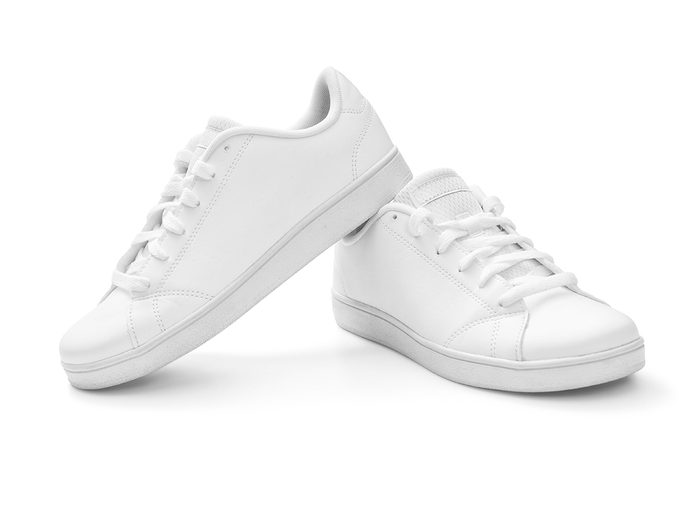
Restore white shoes
Brighten up your dingy white shoes or tennis sneakers by rubbing them with a cloth dipped in half-strength ammonia—that is, a solution made of half ammonia and half water.
Here are more spring cleaning tips that will come in handy all year long!
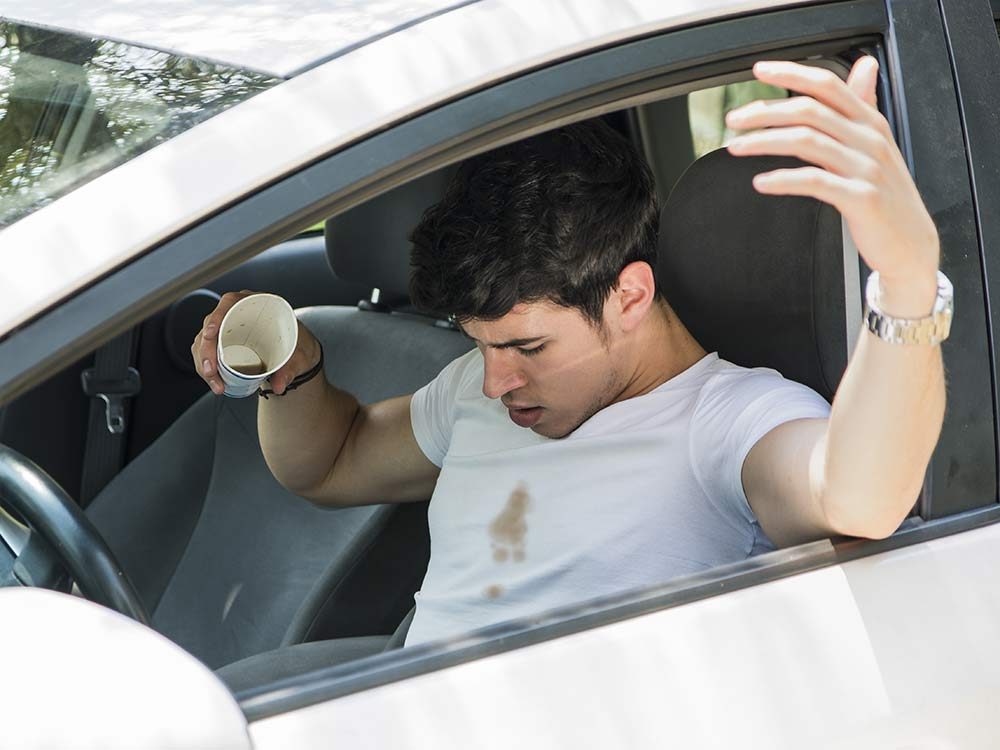
Use ammonia to remove stains from clothing
Ammonia is great for cleaning clothes. Here are some ways you can use it to remove a variety of stains. (Be sure to dilute ammonia with at least 50 percent water before applying it to silk, wool, or lycra.)
- Rub out perspiration, blood, and urine stains on clothing by dabbing the area with a half-strength solution of ammonia and water before laundering.
- Remove most non-oily stains by making a mixture of equal parts ammonia, water, and dishwashing liquid. Put it in an empty spray bottle, shake well, and apply directly to the stain. Let it set for two or three minutes, and then rinse out.
- To erase pencil marks from clothing, use a few drops of undiluted ammonia and then rinse. If that doesn’t work, put a little laundry detergent on the stain and rinse again.
These brilliant laundry hacks will save you time, money and effort.
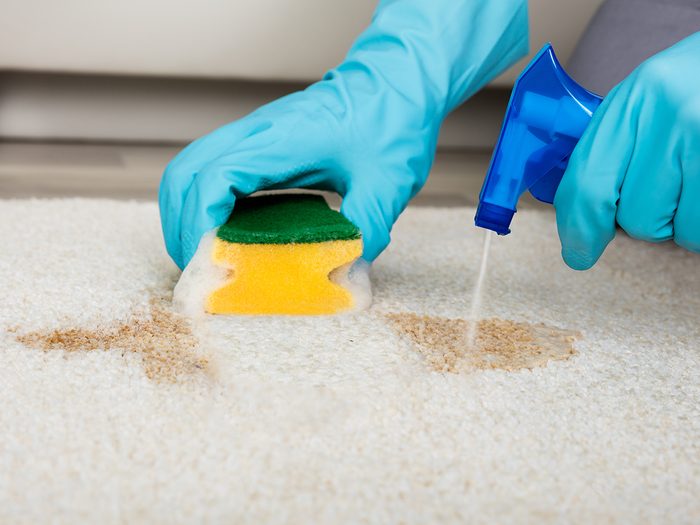
Clean carpets and upholstery
Lift out stains from carpeting and upholstery by sponging them with 1 cup clear ammonia in ½-gallon (2 litres) warm water. Let dry thoroughly, and repeat if needed.
Find out the best homemade carpet cleaners for every kind of stain.
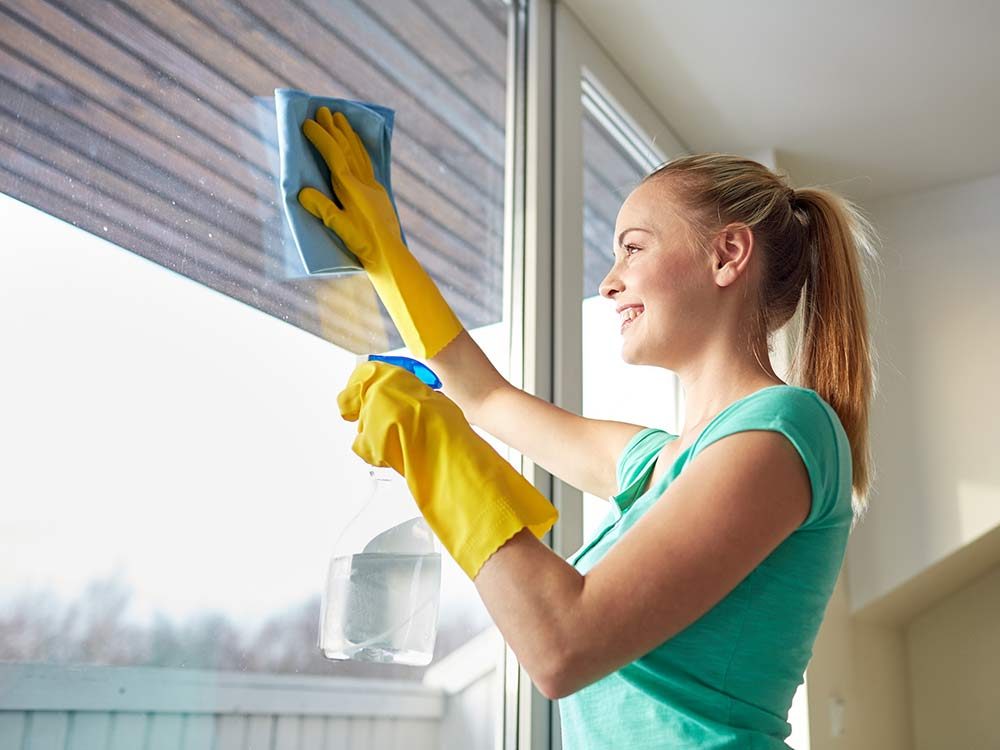
Use ammonia to brighten up windows
Dirty, grimy windows can make any house look dingy. But it’s easy to wipe away the dirt, fingerprints, soot and dust covering your windows. Just wipe them down with a soft cloth dampened with a solution of 1 cup clear ammonia in 3 cups water. Your windows will not only be crystal-clear, but streak-free to boot.
It’s time to bust these 10 cleaning myths once and for all.
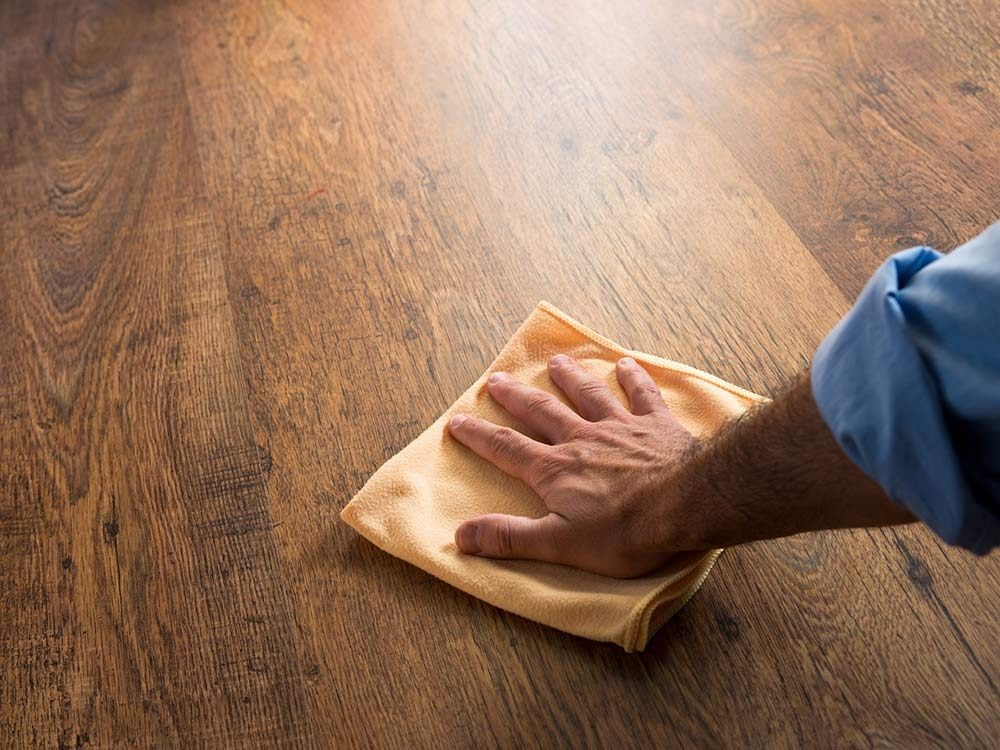
Strip wax from resilient flooring
Wax buildup on resilient flooring causes it to yellow in time. Remove old wax layers and freshen up your floor by washing it with a mixture of 1 cup ammonia in ½-gallon (2 litres) water. Let the solution sit for three to five minutes, then scrub with a nylon or plastic scouring pad to remove the old wax. Wipe away leftover residue with a clean cloth or sponge, then give the floor a thorough rinsing.
Follow our ultimate spring cleaning spot checklist to ensure your whole home sparkles.
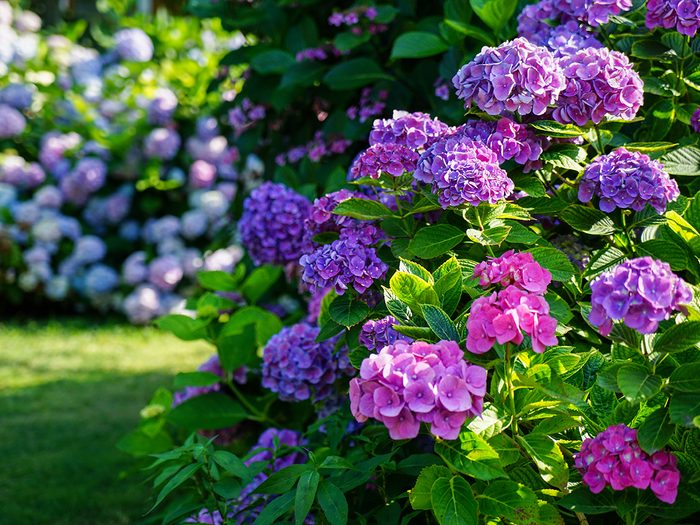
Use ammonia as plant food
Ammonia can be a powerful fertilizer, feeding plants with much-needed nitrogen. Give the alkaline-loving flowering plants and vegetables in your garden—such as clematis, lilac, hydrangea, and cucumbers—an occasional special treat with a shower of ¼-cup ammonia diluted in 1 gallon (3.8 litres) water. They’ll appreciate the boost!
Here are 20 more gardening tips you’ll wish you’d known sooner.
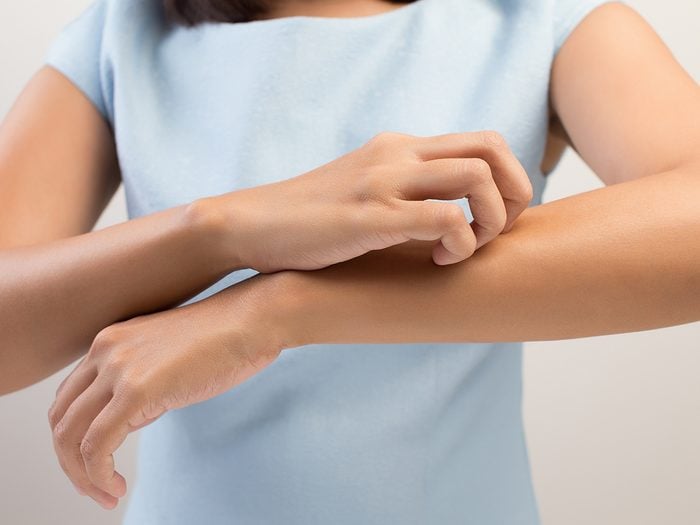
Stop mosquito bites from itching
If you forget to put on your insect repellent and mosquitoes make a meal of you, stop the itching instantly by applying a drop or two of ammonia directly to the bites. (In fact, ammonia is a key ingredient in products like After Bite.) Don’t use ammonia on a bite you’ve already scratched open, though: the itch will be replaced by a nasty sting.
Want to prevent those bites in the first place? These are the best mosquito repellent plants you can grow.
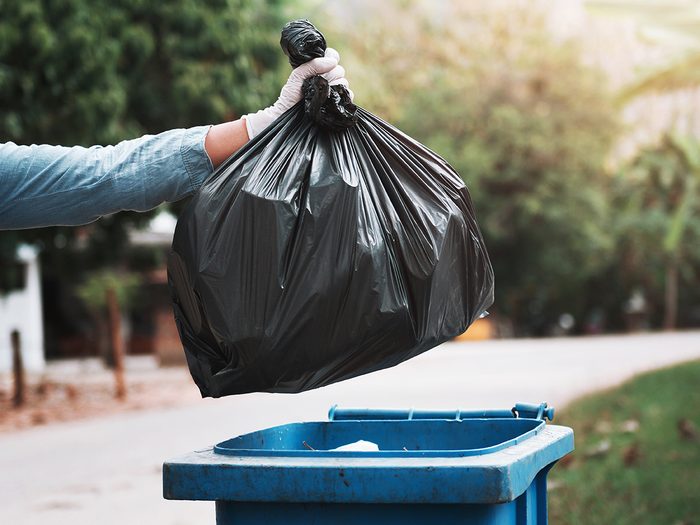
Keep stray animals out of your trash
Few things can be quite as startling as a raccoon leaping out of your garbage bin just as you’re about to make your weekly trash deposit. Keep away those masked scavengers and other strays by spraying the outside and lids of your garbage bins with half-strength ammonia or by spraying the bags inside.
Discover 13 secrets exterminators want you to know.
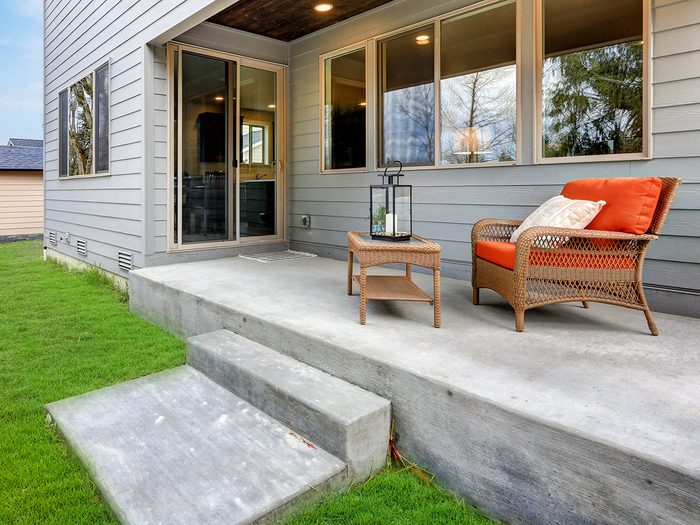
Remove stains from concrete
Tired of those annoying discolourations on your concrete work? To get rid of them, scrub with 1 cup ammonia diluted in 1 gallon (3.7 litres) water. Hose it down well when you’re done.
Here are more budget-friendly ways to boost your home’s curb appeal.
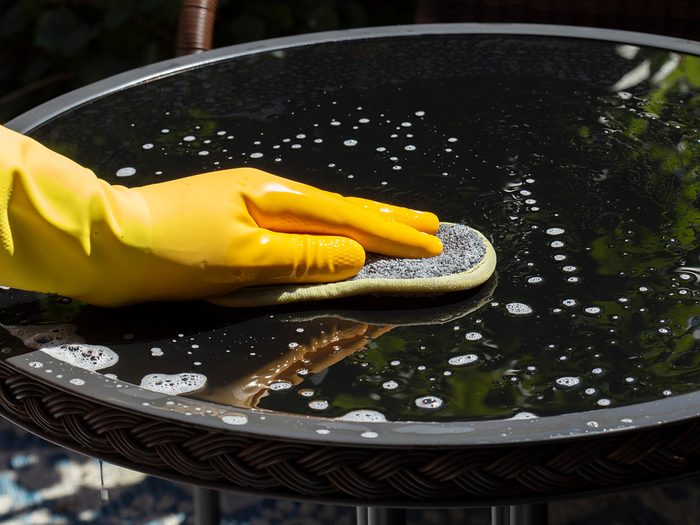
Use ammonia to fight mildew
Ammonia and bleach are equally effective weapons in the battle against mold and mildew. However, each has its own distinct applications, and under no conditions should the two ever be combined. Reach for the ammonia for the following chores, but be sure you use it in a well-ventilated area, and don’t forget to wear rubber gloves:
- Clean the mildew off unfinished wooden patio furniture and picnic tables with a mixture of 1 cup ammonia, ½-cup vinegar, ¼-cup baking soda, and 1 gallon (3.8 litres) water. Rinse off thoroughly and use an old terrycloth towel to absorb excess moisture.
- To remove mildew from painted outdoor surfaces, use the same combination of ingredients.
- To remove mildew from wicker furniture, wash it down with a solution of 2 tablespoons ammonia in 1 gallon (3.8 litres) water. Use an old toothbrush to get into that hard-to-reach twists and turns. Rinse well and let air-dry.